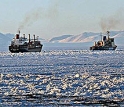News Release 06-031
Cargo, Fuel Safely Unloaded at Antarctic Research Station

The tanker Lawrence H. Gianella sits alongside the ice pier at McMurdo Station in Antarctica.
February 10, 2006
This material is available primarily for archival purposes. Telephone numbers or other contact information may be out of date; please see current contact information at media contacts.
Overcoming challenging ice conditions, a ship has safely delivered cargo needed to supply National Science Foundation research stations in Antarctica through the coming austral winter and into the next research season.
Fuel required to heat the stations and power aircraft and other vehicles is currently being transferred from a tanker into storage tanks on land.
The cargo vessel American Tern arrived at McMurdo Station's ice pier on Feb. 2. With its cargo safely offloaded, and with recyclable materials and other goods stowed aboard, the Tern was escorted out of McMurdo Sound by the Russian icebreaker Krasin earlier this week. The cargo ship has steamed safely beyond the ice-clogged region and is now headed north.
NSF chartered the Krasin to cut and maintain a channel through the thick, multiyear ice covering the Ross Sea and the sound into McMurdo Station.
Meanwhile, the tanker Lawrence H. Gianella is offloading fuel and is expected to complete its operations by Feb. 11, when it too will be escorted north through the sea ice.
With the safe arrival and off-load of the ships, preparations for the long, dark Antarctic winter at McMurdo are nearing completion.
NSF, which manages the U.S. Antarctic Program, maintains two year-round posts on the Antarctic continent: Amundsen-Scott South Pole Station and McMurdo Station. Palmer Station, located on the Antarctic Peninsula, does not rely on the supplies delivered to McMurdo.
-NSF-
-
The icebreaker Krasin escorts the cargo ship American Tern out of McMurdo Sound.
Credit and Larger Version
Media Contacts
Peter West, NSF, (703) 292-7761, email: pwest@nsf.gov
The U.S. National Science Foundation propels the nation forward by advancing fundamental research in all fields of science and engineering. NSF supports research and people by providing facilities, instruments and funding to support their ingenuity and sustain the U.S. as a global leader in research and innovation. With a fiscal year 2023 budget of $9.5 billion, NSF funds reach all 50 states through grants to nearly 2,000 colleges, universities and institutions. Each year, NSF receives more than 40,000 competitive proposals and makes about 11,000 new awards. Those awards include support for cooperative research with industry, Arctic and Antarctic research and operations, and U.S. participation in international scientific efforts.
Connect with us online
NSF website: nsf.gov
NSF News: nsf.gov/news
For News Media: nsf.gov/news/newsroom
Statistics: nsf.gov/statistics/
Awards database: nsf.gov/awardsearch/
Follow us on social
Twitter: twitter.com/NSF
Facebook: facebook.com/US.NSF
Instagram: instagram.com/nsfgov



